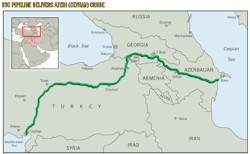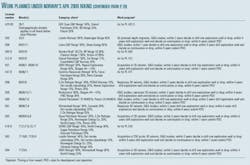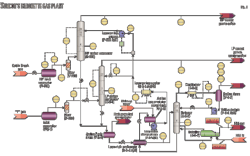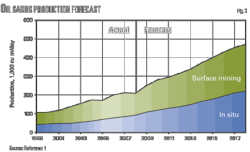GULF MARGINAL PRODUCTION—3: Model tracks structures' transition from marginal to abandonment
In the final part of this series, we estimate the number of committed assets in the Gulf of Mexico that are expected to be marginal over a 60-year horizon.
Our sample set includes all producing structures in shallow water circa January 2007. Structures installed after January 2007, as well as deepwater structures, are not part of the assessment.
We compute the expected quantity and value of production and gross revenue streams using the probabilistic framework and model assumptions outlined in Part 2 (OGJ, Dec. 14, 2009, p. 33). The cumulative hydrocarbon production from the inventory of producing assets is estimated to be 1.056 billion bbl of oil and 13.3 tcf of gas.
Marginal production from the committed asset inventory is expected to contribute 4.1% of total oil production and 5.4% of gas production in the gulf. A meta-evaluation procedure is adopted to present the results of sensitivity analysis.
Structure assessment
Structure count trajectory
The total number of shallow water committed structures that are expected to produce over a 60-year horizon is depicted in Fig. 1 according to marginal and economic categorizations.
The trajectory depicted represents the average of several hundred simulations that sampled the model parameters (d, Po, Pg, m, a, D) from their respective distributions described in Part 2 for each of the 2,364 producing structures in the gulf circa January 2007.
As shown in Fig. 1, the number of structures declines over time as production at individual assets decreases and transition from economic to marginal status, and eventually, to abandonment. When structures transition from economic to marginal status, and then again at a later time from marginal status to abandonment, the number of structures classified as economic and marginal will change.
All structures are removed at their economic limit regardless of the production status of the lease on which they reside.
The number of economic structures decreases monotonically over time, since once a structure is no longer economic, it will not return to economic status since production is declining and price is fixed across the forecast period, and we assume that no investment to acquire additional reserves or slow decline will be made.
Our assessment only covers the existing inventory of structures, and new installations (via future developments) are not considered.
Economic structures transition through a marginal classification, and operate as marginal producers until revenue falls below their economic limit. The size of the marginal subcategory can therefore increase or decrease over time, depending upon the number of structures entering the class (as economic producers) and structures departing (to abandonment).
The absolute size of the marginal class is relatively constant over the first two decades of the forecast horizon. On a percent basis, as the number of economic structures declines, the inventory of marginal structures represents an increasing share of the committed asset inventory (Fig. 2).
Structure count envelopes
We count the number of economic and marginal structures each year for a given value of (d, Po, Pg, m, a) where individual parameters are sampled from their respective distributions. The total number of committed assets is denoted σ(d, Po, Pg, m, a), and the number of economic and marginal structures is denoted σe(d, Po, Pg, m, a) and σm(d, Po, Pg, m, a).
In Figs. 3-5, average counting functions are graphed with a one standard deviation envelope for the total number of structures and the number of economic and marginal producers. It is useful to consider the envelope as bounding the path trajectories that arise from selecting different points (d, Po, Pg, m, a) in the design space.
Each point (d, Po, Pg, m, a) is associated with one path trajectory, and as points are sampled within the design space, individual trajectories will change. If Normality conditions are assumed for the parameters, the actual path realized would be expected to be bound within the envelope about two thirds of the time.
Structure counts are observed to be strictly decreasing functions for producing and economic structures (Figs. 3 and 4). Because the number of economic structures initially dominates the total structure count, the behavior of the composite trajectory (Fig. 3) is expected to closely follow the economic path (Fig. 4). The marginal structure count increases and plateaus for several years before declining (Fig. 5), and because the number of structures classified as marginal are small relative to the economic structure count, the total path trajectory is dominated by the economic class behavior.
During the period of time in which structure production is marginal, new structures enter the class (from economic producers) and marginal structures leave (for abandonment). The relative number of arrivals and departures impact the length of the plateau.
The shape of the marginal trajectory would be expected to play a dominant role when the number of economic structures decline, but at this time, since the shape of the two trajectories are similar and the counts are of similar magnitude, the influence of the marginal trajectory on the composite trajectory is diminished.
Production profiles
Aggregate production
The average annual production from economic and marginal structures is shown in Fig. 6.
The production profile parallels the general shape of the structure count and illustrates the relative contribution provided by economic and marginal assets for each year of the forecast.
Marginal assets produce a fraction of the total production, although over time its relative contribution increases (Fig. 7), as dictated by the model framework (since the committed asset inventory is fixed). In total, production from shallow water marginal structures is expected to contribute less than 5% of the total shallow water production from the structure set.
Production envelopes
Production envelopes for economic and marginal structures are shown in Figs. 8-10. In Figs. 8 and 9, the average production profile for all producing and economic structures is depicted with a two standard deviation envelope. Near the beginning and end of the production forecast for these asset classes the envelopes tend to be very tight, due in part to the relative insensitivity of the total production to parameter variation at these points in time.
As structures age and production transfers to the marginal categorization, the impact of changes in input variables becomes more pronounced. The production envelope of marginal structures maintains a wide interval at the start of the horizon but converges near the end of the forecast (Fig. 10).
Production by asset category
In Fig. 11, the average production is decomposed according to the production classes young, normal, chaotic, latecomer, and unknown defined in Part 2.
In Fig. 12, the cumulative production profiles depict the relative contribution of each asset class. The collection of young and normal producers contributes nearly two thirds of total gulf production; with latecomer assets, 80% of total production is captured.
Summary statistics
Composite statistics for oil, gas, and production from shallow water committed assets in the gulf circa early 2007 are summarized in Table 1.
Production quantity and discounted gross revenue per product stream are decomposed in terms of economic, marginal, and composite classes. The expected amount of hydrocarbon production is estimated at 1,056.4 million bbl of oil and 13.3 tcf of gas, or 3,279 million boe.
The expected discounted gross revenue is calculated as $149.4 billion. Marginal production is expected to contribute 4.1% of the total oil production and 5.4% of the total gas production. We estimate that 1.2% of the total value of future committed production is due to marginal assets.
Regression models
Cumulative production functions
Regression models for the cumulative economic, marginal, and total production are given by Equations 1-3.
The coefficients of the regression models are of the expected sign and statistically significant for most of the variables, and the model fits are relatively high (Tables 2-4). For any input parameters selected within the design space, the output for cumulative BOE production will vary in accord with the regression models shown.
In Table 2, model results for total (cumulative) production are depicted. In Tables 3 and 4, regression results for gas and oil streams are depicted. The model fits in Tables 3 and 4 are improved somewhat over their BOE counterpart due in part to the more homogeneous nature of the production stream. An example is illustrated in the following box.
| Regression functions are useful to estimate total hydrocarbon production for user-defined variables and to investigate parameter sensitivities. From Table 2, selecting the point (d, Po, Pg, m, α) = (0.10, 120, 10, 4, 1) in the design space yields the cumulative production from marginal assets as Qm (0.10, 120, 10, 4, 1) = –1.8E7 + 5.04E7 + 1.1E7 + 3.08E8 – 9.1E7 = 2.60E8 boe = 260 million boe. Similarly, Qe (0.10, 120, 10, 4) = 3.09 billion boe and QT (0.10, 120, 10, 1) = 3.14 billion boe. Cumulative oil and gas production estimates are computed similarly using the results in Tables 3 and 4. |
Valuation functions
The discounted gross revenue of future hydrocarbon production is obtained by monetizing the oil and gas streams at assumed future prices, discount rates, and economic and marginal thresholds. We do not consider capital or operating expenditures, or the impact of tax, royalty, or depreciation schedules in the assessment.
The model results for total boe, gas, and oil production for the economic, marginal, and combined asset classes are shown in Tables 5-7. Equations for the total hydrocarbon production stream are described in $1,000 and given by Equations 4-6.
The use of a fixed-term coefficient is optional and the model results are presented with and without this term. The coefficients of the regression models are of the expected sign and statistically significant for most of the variables, and the model fits are reasonably high.
The most important components of marginal production are the values of m, a, and D; the decline parameter and hydrocarbon prices are less significant. This is not surprising considering the nature of the producing assets. The decline parameter only contributes to the portion of total production due to latecomer structures and is not expected to be a significant model driver. If latecomer structures contributed a larger portion of total GOM production, the significance of the decline parameter would increase. An example of the revenue models is illustrated in the box below.
| The present value of economic production for a 10% decline rate, $100/bbl oil, $10/Mcf gas, and a 15% discount rate is computed to be PVe (0.1, 100, 10, 4, 0.15) = $147 billion. For economic assets, the abandonment threshold does not play a role in determining value, and thus a term for the parameter a is not included in the model. The discounted value and gross revenue for marginal producing assets is computed to be PVm (0 0.1, 100, 10, 4, 1, 0.15) = $3 billion. |
Summary
When the revenue from an offshore structure's production stream approaches its cost of operations, the structure is said to be marginal and its production is classified as marginal.
We operationalized the definition of marginal production based on revenue threshold and classified and forecast economic and marginal production in the shallow water gulf. The number of marginal structures from the current inventory of committed assets and the amount and value of marginal production was forecast for a 60-year time horizon.
A simulation strategy was employed that combined scenario analysis defined through a probabilistic design space and a meta framework to investigate the impact and sensitivity of input variables on model output. Count and production trajectories were presented for economic and marginal structures for oil, gas, and boe forecasts.
Regression models were used to simplify and synthesize results on the impact of variability in the design parameters. We forecast both numeric and vector quantities. Numeric quantities are easier to configure and compute, while vector quantities require more advanced techniques to handle.
Acknowledgment
This article series was prepared on behalf of the US Department of the Interior, Minerals Management Service, Gulf of Mexico OCS region, and has not been technically reviewed by the MMS. The opinions, findings, conclusions, or recommendations expressed are those of the authors and do not necessarily reflect MMS views. The US Department of the Interior and the Coastal Marine Institute, Louisiana State University, funded this research.
The authors
Australia
Beach Petroleum Ltd., Adelaide, and ATCO Ltd., Toronto, signed a memorandum of understanding to investigate opportunities to develop and commercialize Beach's unconventional shale gas and liquids resource in Australia's Cooper basin.
Beach and ATCO will focus on the gas gathering, processing, transportation, and distribution requirements of the unconventional gas development program. The parties may also consider the feasibility of using commercialized discoveries of unconventional gas to fuel a gas-fired power plant.
Beach has a dominant shale gas acreage position in the Nappamerri Trough in the Cooper basin through its acquisition of interests in PEL 218, where it has a 90% interest in Permian strata and 23.33% in post-Permian strata, and ATP 855, where it holds up to a 40% working interest.
The Nappamerri Trough straddles the South Australian-Queensland border at the heart of the Cooper basin and is considered the source kitchen for the oil and gas fields on the margins of the trough.
Initial work by Beach in this area suggests the potential for a world class shale gas resource of tens of trillions of cubic feet, Beach said.
China
Far East Energy Corp., Houston, let contracts for five rigs that are to begin drilling coalbed methane development wells starting in mid-December 2009 on the Shouyang block in China's Shanxi Province.
Gas production on the block has surpassed 500 Mcfd as earlier wells dewater. Far East plans to drill and frac nine new wells by mid-February 2010 and frac its existing P4 well.
Eight of the new wells will continue the westward expansion of the high permeability field, and one will be a new parameter well several kilometers west to test extent of the high permeability-high gas content area.
Two pipelines and one local distribution-compressed natural gas company have indicated a desire to purchase the gas produced from the Shouyang Block.
Indonesia
Tap Oil Ltd., Perth, plans to earn a 24% interest in the 3,977 sq km Rangkas block onshore West Java, Indonesia, from Lundin Petroleum AB, Stockholm, the operator.
Previous exploration seismic and drilling in the block, along with the presence of surface oil seeps, indicates the presence of an active petroleum system. Recent reviews of the block, including seismic reprocessing, resulted in Tap and its proposed joint venture partners concluding that the previous wells were not valid tests of the prospectivity.
Leads identified on 2D seismic data will be the target of a new seismic survey of up to 500 line-km in the first half of 2010. Depending on results, the joint venture may commit to additional seismic and drilling in 2011-2012.
Block interests are Lundin Rangkas BV 51%, Carnarvon Petroleum (Indonesia) Pty. Ltd. 25%, and Tap Oil 24%.
Alabama
Venture Oil & Gas Inc., Laurel, Miss., gauged an exploratory well off the southeast flank of Huxford (Smackover) field in Escambia County, Ala.
The 1 Mason 36-14, in 36-2n-6e, 22 miles west of Brewton, flowed at the rate of 457 b/d of 43° gravity oil and 538 Mcfd of gas on a 10⁄64-in. choke with 2,627 psi flowing tubing pressure from Smackover perforations at 14,902-936 ft. Gas is 1,500 ppm hydrogen sulfide.
Oklahoma
Red Fork Energy Ltd., Perth, said a well east of Vinita, Okla., logged 52 ft of Devonian Woodford shale above TD of 485 ft with excellent log characteristics and gas shows across the entire section.
The well is the Wattenbarger 1-22, in 22-25n-21e, Craig County, 5 miles east of Vinita. Top of Woodford shale is at 385 ft.
More Oil & Gas Journal Current Issue Articles
More Oil & Gas Journal Archives Issue Articles
View Oil and Gas Articles on PennEnergy.com









